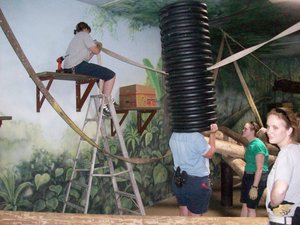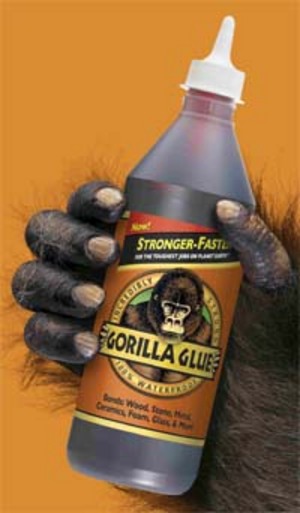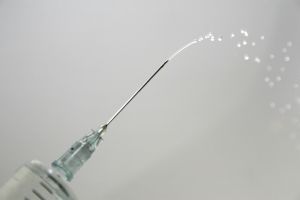“Wow! You must have such a fun job!”
This is a phrase I hear a lot, both at work and out socially. Don’t get me wrong, I absolutely love my job. Working with animals in a zoo is both fun and rewarding. I get to tickle a gorilla’s toes, talk to parrots and watch a snow leopard grow from a squiggly cub to a beautiful adult. But there is much more to zoo keeping than “playing with animals” all day. The job it dirty, smelly, and physically demanding. I work outside when the weather is bad, get wet, lift heavy objects, and fill out what seems like endless amounts of paperwork. Zoo keepers are landscapers, construction workers, chefs, cruise directors, electricians, and secretaries. Want an inside look at some of the tasks a zoo keeper completes in a day? Read on!
Cleaning Enclosures
Animals poop. Some animals poop in a designated spot every day, like cats. Some animals poop while they walk, like sheep. A huge part of my day is cleaning up poop of all kinds. Sizes range from mouse to elephant. Keepers use hoses, rakes, brooms, scrapers, dustpans, shovels and wheelbarrows to make sure the enclosure is clean for the animals. And yes, some of it smells. Smelliest poop? Ocelot. Hands down.
Exhibit Maintenance
Besides daily cleaning, most animal exhibits need routine maintenance. This may include changing light bulbs, rearranging vines and ropes and repairing lounge areas. We may add new branches and shelves or dump new substrate such as dirt or sand. Some exhibits even require weed-wacking and tree-trimming, or filling in holes dug by the animals themselves.
Preparing Diets
Animals need to eat, and they all have special nutritional needs and personal preferences. Keepers spend hours each day chopping veggies, slicing fruits, measuring various dry biscuits and kibbles, and preparing meat, bones and whole prey. Yes, whole prey. Snakes almost always need whole mice, rats, and even rabbits. We also feed out pigeons, chicks, live insects and various kinds of whole fish to our cats, wolves, and birds of prey. Feeding can require heavy lifting for elephants, giraffes and hoof stock, carrying large bales of hay or alfalfa, sometimes several for one meal. Food prep also includes unloading deliveries of meat, hay, produce and dry foods.
Enrichment and Training
Any good zoo has in place a way to keep animals entertained though the day. Enrichment is a strategy for making the animals’ lives more interesting and giving them choices. It includes toys to play with, new things to look at or smell, different foods and new exhibit furniture. Training also keeps the animals stimulated, as it gives them an option to use their problem-solving skills and interact with keepers for rewards.
Medical Procedures
Whether its routine vet exams or a surgery, keepers are very involved in medical aspect of the animals’ care. Daily medications are delivered by keepers, and many times we have to get creative with our delivery, hiding the pills in chunks of meat or mixing liquid with honey or peanut butter! Many training behaviors the keepers work on are to make medical checks easier for both patient and caregiver. Keepers may even participate in injections, blood draws, ultrasounds and x-rays.
Public Areas
Keepers are responsible for maintaining the areas where visitors come to look at the animals. This includes a lot of window-washing, floor scrubbing, and cobweb sweeping. They may even have to clean bathrooms, vacuum, and dust.
Paperwork
Zoos keep records of everything; there are daily logs, enrichment logs, med logs, training logs, even logs for bowel movements or estrous cycles!
Volunteers and Interns
Most zoos welcome volunteers and interns, which can range from high school students to retirees. Keepers need to be able to direct and monitor volunteers, making sure they understand what needs to get done and that the work gets completed.
Public Speaking
A good zoo considers education to be one of their primary goals. Keepers are expected to engage and inform the public about the animals themselves and their wild counterparts. Most zoo visitors enjoy and look forward to interaction with keepers. We may even be asked to talk to news reporters or be on camera for special events at the zoo.
Conservation
From raising money to going on field research trips, keepers today are heavily involved in making our planet a better place for the future. This could mean traveling to an exotic local, or working on local conservation projects right in your own county or state.
Professional Development
Zoo keepers have the option of joining a professional organization, the American Association of Zoo Keepers. This is a national group of keepers dedicated to advancing the science of good animal care. We write papers, hold conferences and classes, and exchange ideas in online forums. Keepers may do research and work on national committees in addition to all their daily duties at the zoo.
A zoo keeper today is much more than a glorified “sh*t shoveler”. We take pride in giving the animals in our care the best lives we can offer, and always push ourselves to do more. Still interested in a job at a zoo? Read this article for places to look for jobs.






